- Home
- What is Calisthenics
- Calisthenics Leg Workouts
Calisthenics Leg Workouts: Strong Legs No Equipment Required
Calisthenics leg workouts to get your legs strong and toned in the comfort of your own home. No equipment required.
Beth's 1 Week Meal Plan

Do you want a workout that will send you weak at the knees?
Probably not. Ha!
What if I said a
workout that would give you super strong legs?
Getting a little
more interesting?
How about, will help
you get more defined legs?
Well, I’ve got
workouts that are all three.
How about it? Up for
the challenge?
I take no
responsibility for you not being able to walk for a few days.
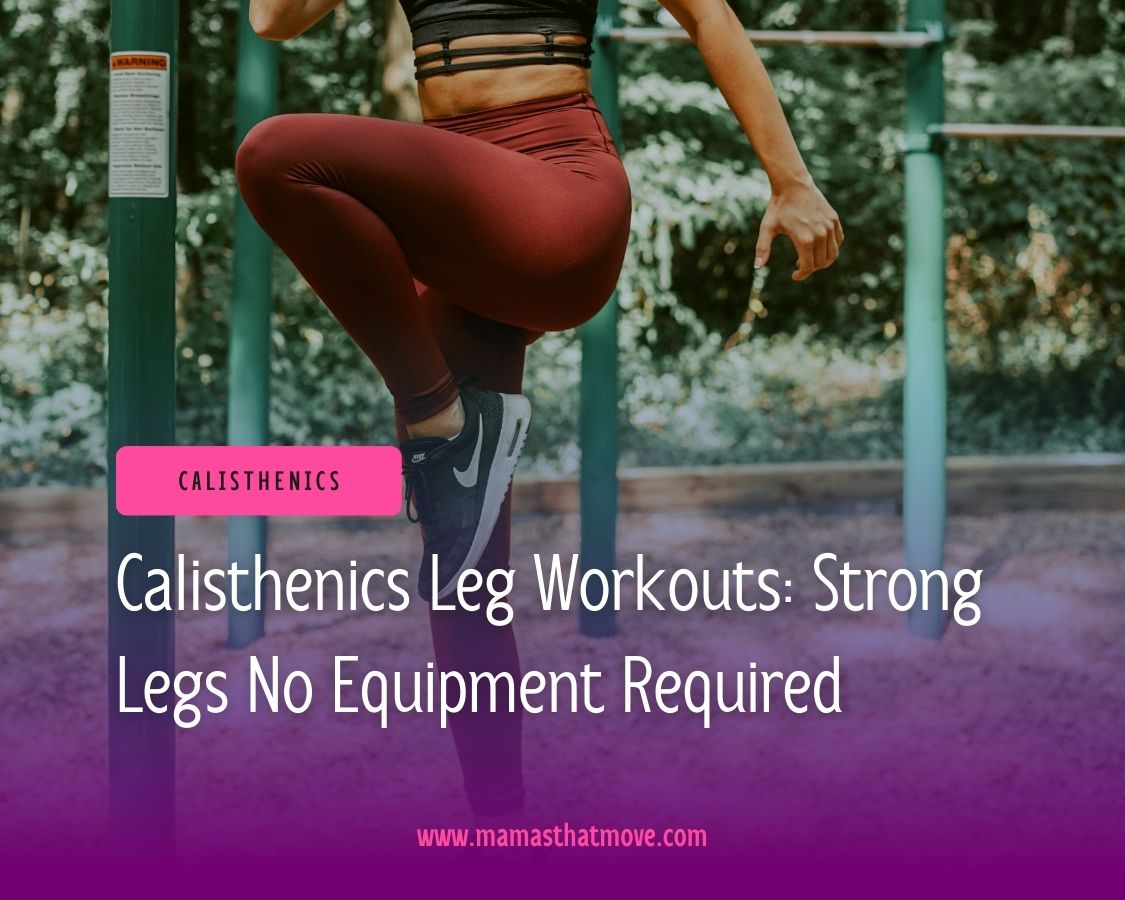
Calisthenics Leg Workouts: What is Calisthenics?
Just to recap,
calisthenics is a form of strength training that uses just your own
body weight and gravity to get you stronger, fitter and leaner.
It’s a great way
of training.
Bodyweight training
is so versatile and can be done anywhere.
Taking the kids to
the park? Do a bodyweight workout.
Waiting for the kids
to come out of their swimming lessons? Do a bodyweight workout.
Wherever you are you
can do a bodyweight, calisthenics workout.
And bodyweight
workouts you can really have fun with.
I love them. Don’t
get me wrong, I love training with weights as well, but bodyweight
workouts lend themselves to thinking outside of the box when it comes
to exercise choice.
Let me explain, when
you’ve got weight in your hand the exercise is tough enough, so we
keep it simple and basic. Squats, lunges, whatever, it’s the
standard variation.
But, when we go for bodyweight exercises, the world is our oyster. We’re going to make those leg muscles sing for their super.
Calisthenics Leg Workouts: What are You legs Muscles?

Before we get on to
the exercises, and then the workouts, I’m just going to touch on
the muscles we’re going to be focusing on with these workouts.
It may be boring,
but I think it’s important for you to know.
That way, you’ll
know exactly what you’re doing, and if you want to change up the
workout at all, you can substitute in exercises that work the same
muscles.
So, you legs,
they’re made up of four main muscle groups.
The quadriceps,
these are on the front of your leg and would be what you refer to as
your thigh. The quadriceps is a group of 4 muscles, I won’t go into
the specifics of each muscle, because I don’t think you need to
know that level.
They are a big
muscle group, so they need to be worked. When they are worked they’ll
reward you with lots of power and help kicking, jumping, running and
walking.
The hamstrings,
these are on the back of your leg, your thigh, but this time it’s a
group of three muscles.
Your hamstrings are
primarily responsible for extending your leg back and bending your
knee.
Be careful when
you’re training these muscles. They are prone to injury. Not
because they’re weak, I don’t think that’s the case. I think
people tend to go heavy, with certain exercises when they’re not
really strong enough too.
Remember, you’re
only as strong as your weakest muscle.
So, please don’t
push yourself too far. This is where working with a personal trainer
really can help. They can spot when you push yourself, and when it’s
far enough. Before you go too far.
Ok, back to leg
muscles….
Adductors, these are
mainly the sides of your thighs. Their job is to adduct, move your
legs to the sides. Mainly towards your middle, but also away from
your body.
Side leg raises are
great for working these muscles.
Lastly it’s shins
and calves. These are obviously really important, but I’m not going
to go into too much detail because generally these are going to be
worked. Whether you’re doing squats, lunges, calf raises, leg
raises, jump squats or sissy squats. These muscles will be worked.
There are some other
groups of muscles that deserve a mention here, your glutes and your
hip flexors.
They’re not
technically considered your leg muscles, but they work closely with
all of your leg muscles so it’s worth considering those in any
workout you want to plan/do.
Your glutes, I’ve
covered these a lot in my 4 week glute workout plan. They’re
essential when it comes to walking and running, so really important
to include with your legs, especially your quads.
Your hip flexors, bring the knee closer to the chest.
Disclaimer
Before we go any
further, I’m going to say what I always say...make sure you can do
the following exercises with proper form before attempting them in a
workout.
As with HIIT,
strength training is demanding and we might be working with
bodyweight exercises rather than with heavy weight, but the risk of
injury is still high. So, please, make sure you can do all of these
with good form.
If you can’t, or don’t want to work with a personal trainer locally, do get in touch. We can go through your form together.
So without any further ado, let’s get on with the exercises…
Calisthenics Leg Workouts: Bodyweight Leg Exercises
So, before we go any
further, there are lots of lower body calisthenics exercises and I’ll
go into a few of them below. But, they all come into two basic
categories, squats and lunges.
There are a few that
fall outside of those two, but, mainly lower body exercises are
either squats or lunges.
Do you need to do
both?
Yes.
Lunges and squats
may work very similar muscles, but they do them in different ways.
They hit your muscles from different angles. Lunges work your body
unilaterally, that means they work one side at a time. This helps to
balance up any weaknesses.
So, yeah, you need
to do both.
Let’s look at the squats and squat variations first…
Calisthenics Leg Workouts: Regular Squat
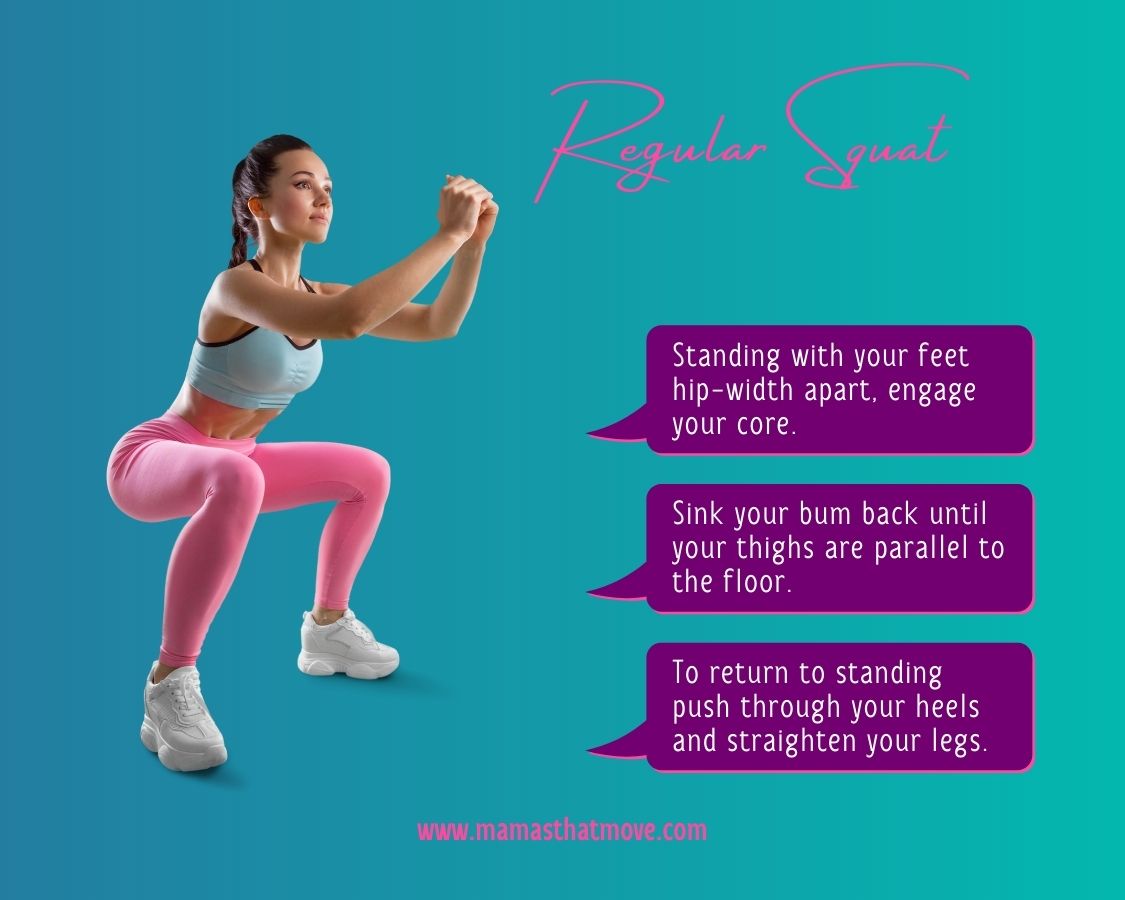
Also known as
bodyweight squats or an air squat.
It might have
different names, but, it’s probably the best known lower body
exercise.
They work pretty
much all of your lower body muscles, your glutes, your quads, your
hamstrings, your adductors, your hip flexors and your calves. It’s
why they’re so well used.
So, how do you do a
squat properly?
Standing with your
feet hip width apart, engage your core, and sink your bum back and
down. Keep sinking until your your knees are bent to about 90-degrees
and your thighs are roughly parallel with the ground.
Pause for a brief
moment, return to a standing position by pushing through your heels.
A few key points,
keep your chest lifted and your knees tracking over your feet. If
your knees start to turn in your stance might be a little wide so try
bringing your feet closer together. If it keeps happening, it could
be that your legs need a bit more strengthening, or your joints
aren’t flexible enough.
You could try
strengthening your legs with lunges, before you move on to squats.
So now you know the basic move, let’s talk about some of the fun variations you can do.
Calisthenics Leg Workouts: Bulgarian Split Squat
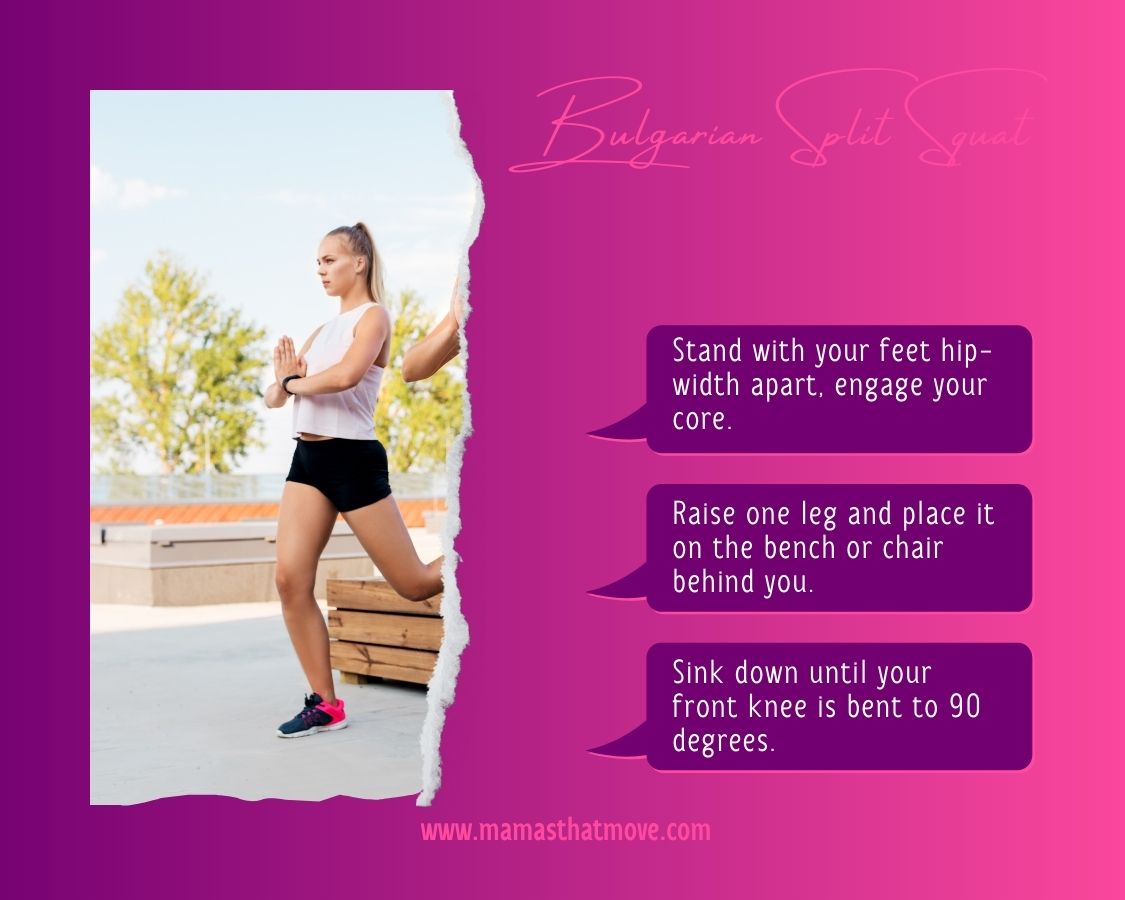
I’ve put this one
first, because it’s another one you could try if regular squats are
proving a little difficult.
It’s a very
similar motion to lunges, but your rear foot is on an elevated
surface. Rather than both feet on the floor.
They work very
similar muscles to squats, and lunges for the matter, and they do it
in a unilateral way which means they’re going to help balance up
any weaknesses.
How do you do them?
You will need a hard
surface to put your foot on, it should be about knee height, so a
coffee table, or chair would work well.
Standing with your
feet hip-width apart in front of the table or chair, lift your right
leg, resting your right foot on the table. Engage your core, bending
your left knee, sink your right knee towards the floor, without
actually touching it.
Return to a standing
position by pushing through your front heel.
To make this a real strengthening move, slow it down. Sink down to a count of 3 and raise back up to a count of 3. You could go even slower.
Calisthenics Leg Workouts: Archer Squat
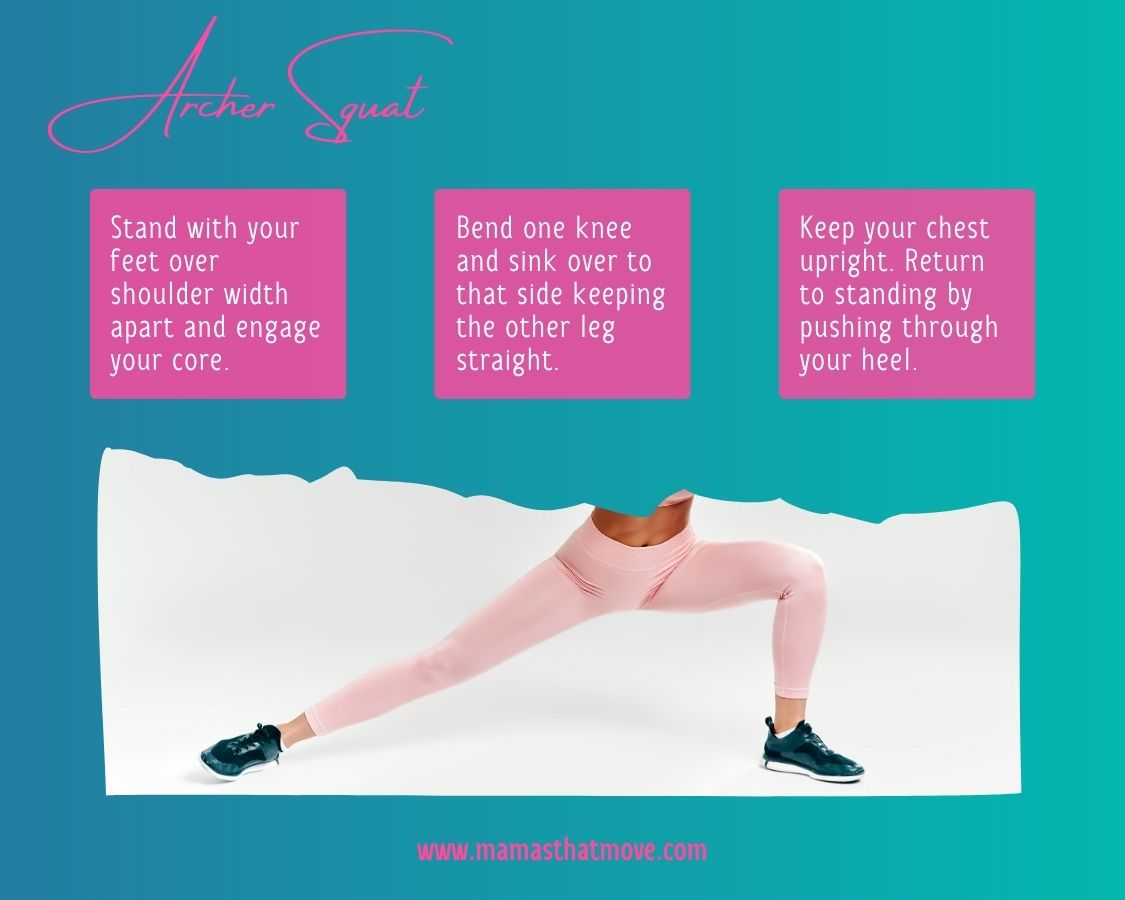
The archer squat is
a little different. It’s a side to side motion rather than an up
and down motion.
It’s a great one
to work your inner things and get some mobility in your ankles.
How do you do them?
You have to take
quite a wide stance, so feet over shoulder width apart. Engage your
core and bend one knee, sinking over to that side and keeping the
other leg straight and your chest as upright as possible.
You should feel a
stretch on the inside of your thigh.
Return to the starting position by pushing through your heels. And repeat on the other side.
Calisthenics Leg Workouts: Jump Squat

Jump squats are more
of a cardio exercise, they’re done quickly. Up, down, up down. They
get your heart rate up.
You might be
wondering why I’m including a cardio exercise in, what will
primarily be a strength workout. Well, combining strength and cardio
in the same workout can help you lose weight faster, and you’ll get
your workouts done faster.
So, that’s why
jump squats are included here.
How to do them?
Jump squats are like
regular squats but instead of returning to a standing position slowly
by pushing through your heels, you jump up explosively and land in a
lowered squat position.
Jumping can have an impact on your pelvic floor, so if you do have pelvic issues, stay away from jumps and speak to a pelvic floor physiotherapist.
Calisthenics Leg Workouts: Shrimp Squats
This may be a new on
on you.
It’s a single-leg
squat but it’s not quite as demanding as a pistol squat. So, if
you’ve got designs on doing one-legged squats, this is a good
practice version.
Being a one-legged
it is a uni-lateral exercise so again it will help to even up any
imbalances.
How do you do a
shrimp squat?
Standing with your
feet hip-width apart, engage your core and bend one leg up behind
you, grasping your foot. Raise your other arm up in front of you, at
shoulder height.
Bend your other
knee, sinking your bum back and down behind you.
The knee on your
raised leg should hover above the floor.
Now, I don't profess that all of the different variations of squats. It's not. Nowhere near. But, I don’t want to overwhelm you or make the workout too complicated.
Keeping things simple is the way forward when it comes to making life changes. So, let’s move on to the lunges…
Calisthenics Leg Workouts: Forward Lunge
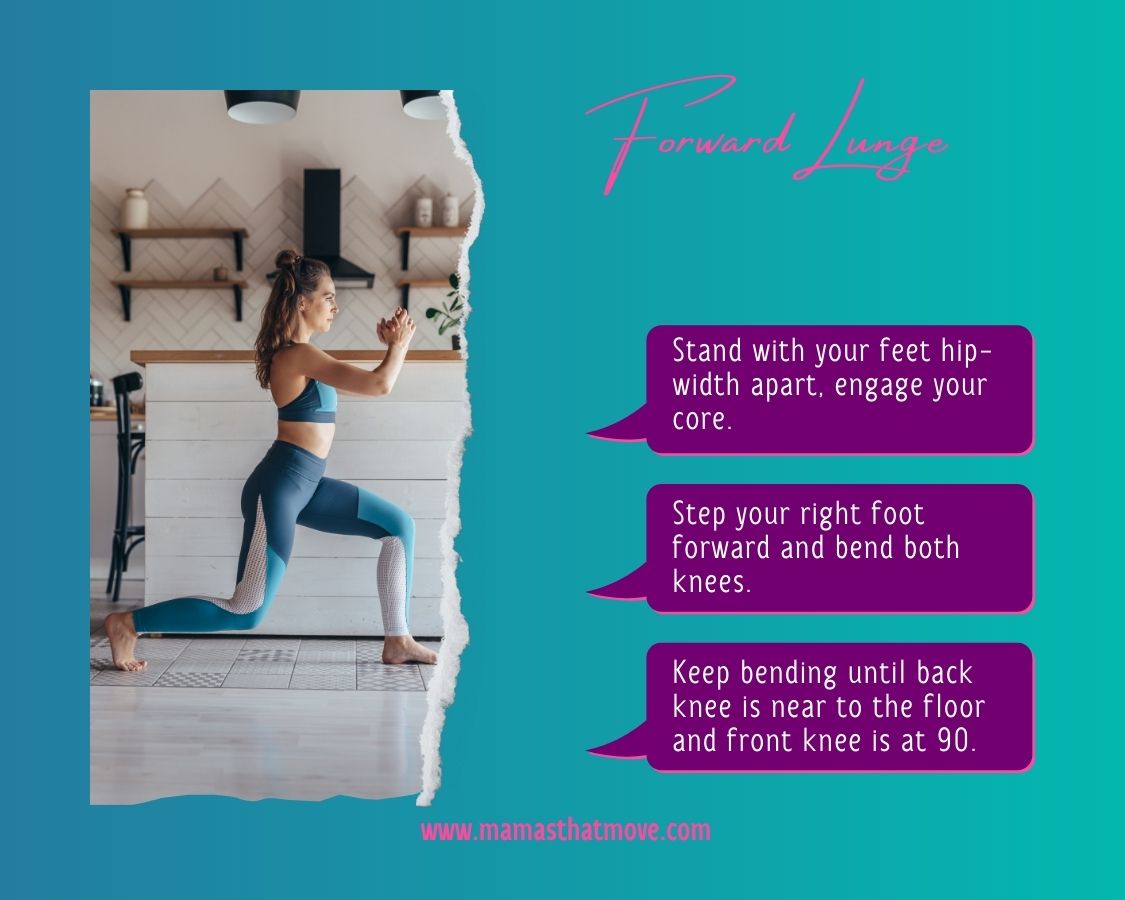
Another basic
exercise, but such a good one to have in your arsenal.
Lunges are great for
working all of the muscles in your lower body, improving your
balance, your hip flexibility and your core stability.
They work your
muscles in slightly different ways to squats, it’s a different
movement, so it’s definitely worth doing both lunges and squats.
How do you do them?
Standing with your
feet hip-width apart, engage your core and take a large step forward,
bending your front knee as you do.
Your back knee
should hover above the floor.
Return to the starting position by pushing through your front foot. Repeat on the other side.
Calisthenics Leg Workouts: Reverse Lunge
Wait, aren’t these
going to be very similar to forward lunges?
Well, yes. And no.
Reverse lunges will
work the same muscles as forward lunges, but, the movement is
actually more stable and less ouchy on the knees.
With a forward lunge
you’re stepping forward with your whole foot, and your leg is very
briefly straight. That can be quite jarring for the knees. There’s
nothing there to cushion the blow from that impact with the floor.
All of this is very
slight and very quick, so it’s unlikely to cause an issue with your
knees if you haven’t already got one. But, if you have got one, it
could be quite painful.
The other issue with
forward lunges is, as you take that step forward, your back heel
lifts off the floor almost immediately. So, for a part of the
exercise the only base you have touching the floor are your toes on
your back foot.
Again, if you have
issues with balance you could find forward lunges quite difficult.
If you do, substitute in reverse lunges until you feel a bit stronger.
How do you do a reverse lunge?
It’s a very
similar motion to a forward lunge, but instead of steeping forward
you’re taking a big step back.
So again, standing
with your feet hip-width apart, arms by your side, engage your core
and take a big step back.
As you do, bend your
front knee and sink down so that your back knee almost, but not
quite, touches the floor.
Return to standing
by pushing through the toes on your back foot and straightening your
knee.
You can bring your arms up in front of you as you step back and down. This will act as a bit of a counterbalance if you’re a bit wobbly.
Calisthenics Leg Workouts: Walking Lunge
Like the jump squat
is this done quickly and will get your heart rate up. Actually
they’ll all probably get your heart rate up, but with this movement
we’ll be getting the cardio system involved.
It’s a forward
lunge, but instead of returning to a standing position, you’ll push
through your back toes and your back leg will come through and take
the next step forward.
If I have trouble
with my knees can I do the walking lunge backward?
I can’t say I’ve
ever tried to walk lunge backward, I might give it a go today, but I
don’t see why not.
It might take a bit
more co-ordination and make sure the area is clear before you start
lunging, but it should be fine.
If any of these
exercises feel a bit tough for you at the moment, maybe you’re
suffering with knee pain, your legs just aren’t strong enough, or
your balance is a bit off, then start with leg raises.
They are a great exercise to strengthen your legs if squats and lunges are out for now.
But, keep trying with these exercises. It’s always good to acknowledge exactly where you are and what your body can do at this moment in time, but don’t put yourself in a ‘I can’t do squats box’. The strength will come. Keep trying.
Ok, onto the workouts…
Calisthenics Leg Workouts: Leg Day Workout
Workout 1: Strength and Cardio

This one will get
your legs burning. You’ll be using the same muscles so they will
fatigue. But, it’s a great way to build strength.
If you don’t think
you can make the full 20 rounds, cut them down. Start with 5 and see
how you get on. I bet you’ll find it tough, but it will be doable.
You might even kick yourself afterwards for not doing it all.
So, you’re going
to have a strength exercise and a cardio exercise. Do the first one
for 10 reps and the second one for 20 seconds. It should take you
about 30 seconds in total for a five minute round. Rest where you
need to.
- Regular squat/Jump Squats
- Forward lunges/Walking lunges
- Archer squat/Mountain Climbers
Workout 2: All About Strength
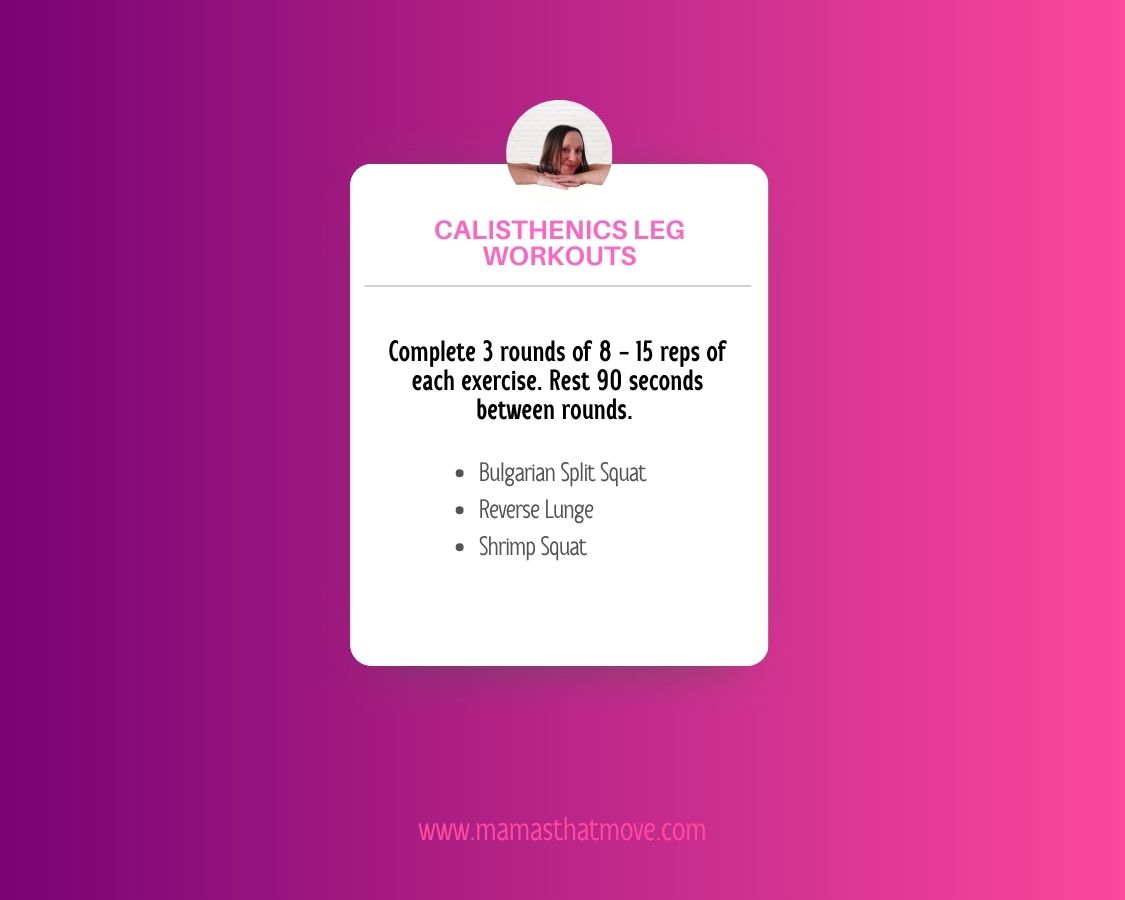
For this one, we’re
going to keep it simple. A straight up strength building workout.
Each exercise 8-15 reps, three rounds and then move on to the next
exercise. Rest for 90 seconds between rounds.
It should feel
tough, if you’re getting through 15 reps and you don’t feel like
you need the rest, then try a harder version or move on to the next
workout.
- Bulgarian Split Squat
- Reverse Lunge
- Shrimp Squat
Workout 3: Super Strong
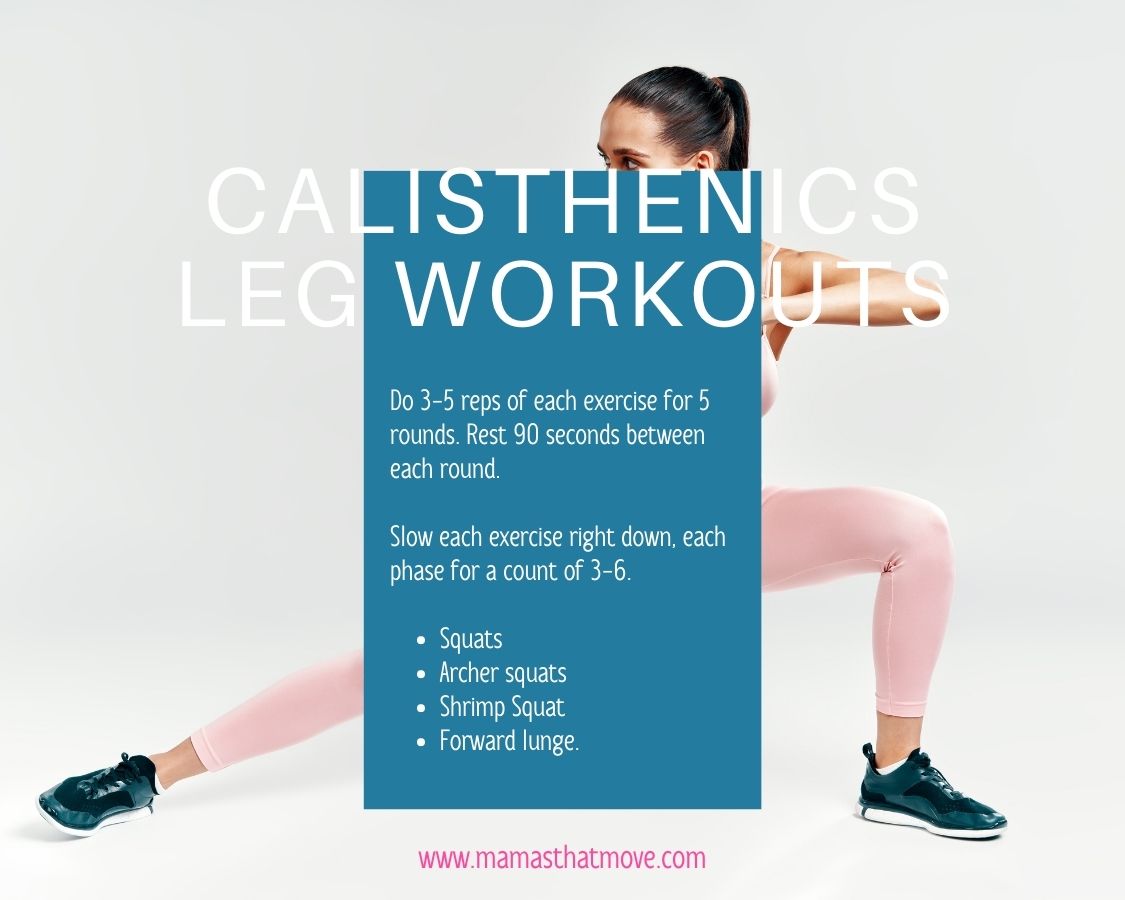
This workout is
designed to get you super strong legs. It’s the progression from
workout 2. So, when you get to 15 reps of each exercise for 3 rounds
and it feels fairly comfortable then move on to this workout.
You can add all
three workouts to your routine, obviously you will need an upper body
workout in there as well.
This time we’re
going to slow everything down.
I love slowing
things down. Clients think it’s going to make the exercise easier.
It won’t get your heart rate up.
They’re always
surprised.
Each phase of the
exercise you’ll do for a count of 3-6. You can start with a count
of 3 and work up to a count of 6.
So with squats, down
for a count of 3, hold at the bottom for a count of 3 and up for a
count of 3. Straight into the next rep.
We’re aiming for
3-5 reps of each exercise for 5 rounds. Rest 90 seconds between each
round.
- Squats
- Archer squats
- Shrimp Squat
- Forward lunge. Start the count after you’ve taken the step forward.
Calisthenics Leg Workouts: Let’s Get Strong Legs
Whichever
calisthenics leg workout you choose, or maybe you’ll try all three,
there’s no doubt you’ll have stronger and more toned legs because
of them.
Make sure you
challenge yourself, but don’t push yourself too hard.
Take rest where you
need, and recover properly.
If you’ve enjoyed
these workouts and you want more, join the Mamas that Move VIP club.
You’ll get
exclusive workouts, tips, tricks and advice delivered straight into
your inbox.
No more searching the web for hours to find a workout to help you reach your goals. You’ll have them delivered straight to you.
Get Your Ultimate Free Eight Week HIIT Workout Plan
Get fitter, stronger and leaner in just eight weeks with my printable HIIT workout Plan. Just 30 minutes a day is all you need.
Want to know more before you sign up?
Check out Printable HIIT Workout Plan to learn all about the plan, what's involved and why you should get it.





